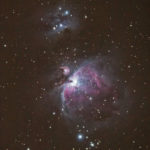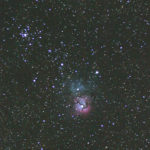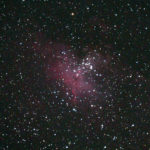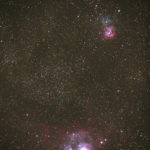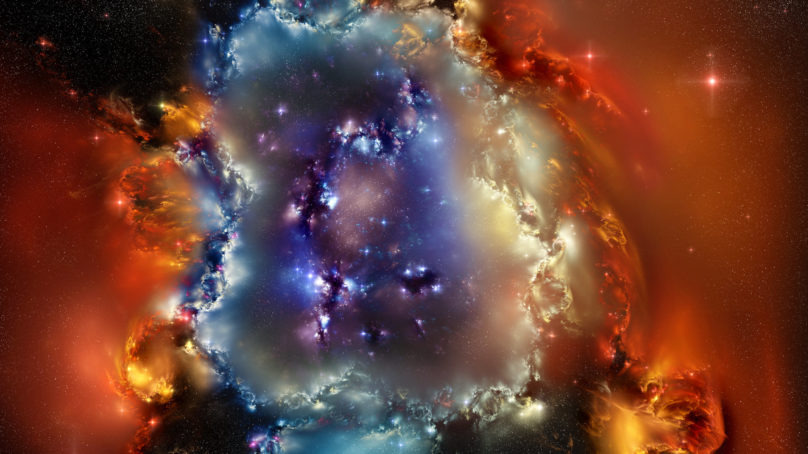
Nebulae are one of the most abundant objects for amateur astronomical study and are very rewarding to photograph. A bright nebula can be counted amongst the most inspiring splendours nature has to offer. What’s more, they are generally very diverse with a wide range of dimensions, magnitudes, and availability to small telescopes. Nebulae are fascinating: what could be more wonderful than contemplating these celestial objects, contemplating a snapshot in time of stars being born, imagining the emergence of planetary systems, and even in some well developed areas, perhaps the bombardment of surfaces that may become conducive to life? Their ethereal nature, short lifetimes, and range of forms make observing them a truly pleasing study.
A Brief History of Nebulae

An illuminated leaf from Ptolemy’s Almagest, in French, Bibliothèque Nationale, Paris, 1213 Manuscript.
In the ancient world, the book that survived—and was used for almost one and a half millennia—was the Almagest by the Alexandrian astronomer Claudius Ptolemy. This text included seven nebulous objects, three of which were starry asterisms, but not physically related objects. Two were taken from Hipparchus’ existing catalogue of fixed stars, and two were new: one is now known colloquially as Ptolemy’s cluster and is the star cluster recorded as Messier 7; the other makes up most of the constellation of Coma Berenices, the star cluster Melotte 111. However, it must be emphasized that these are not nebulae in the true sense of the word; in pre-telescopic times these were unresolved clusters of stars, not collections of gas and dust.
The first person to recognize and discover a nebula in the true sense of a gaseous cloud was Nicholas de Peiresc, who saw the Orion nebula in 1610. It is notable that it is also the first deep sky object ever discovered with a telescope, though Galileo did note that the Beehive cluster in Cancer could be resolved into stars—not a true nebula in any sense. He did, however, observe the Orion nebula without noticing a gaseous component. That the true nature of nebulae were still a mystery and not identified as gaseous clouds can be seen from the claim of Simon Marius on his discovery of the Andromeda galaxy in 1612, the first person in the West to record the object.
Caption: NASA’s Spitzer and Hubble Space Telescopes teamed up to expose the chaos that baby stars are creating 1,500 light years away in a cosmic cloud called the Orion nebula
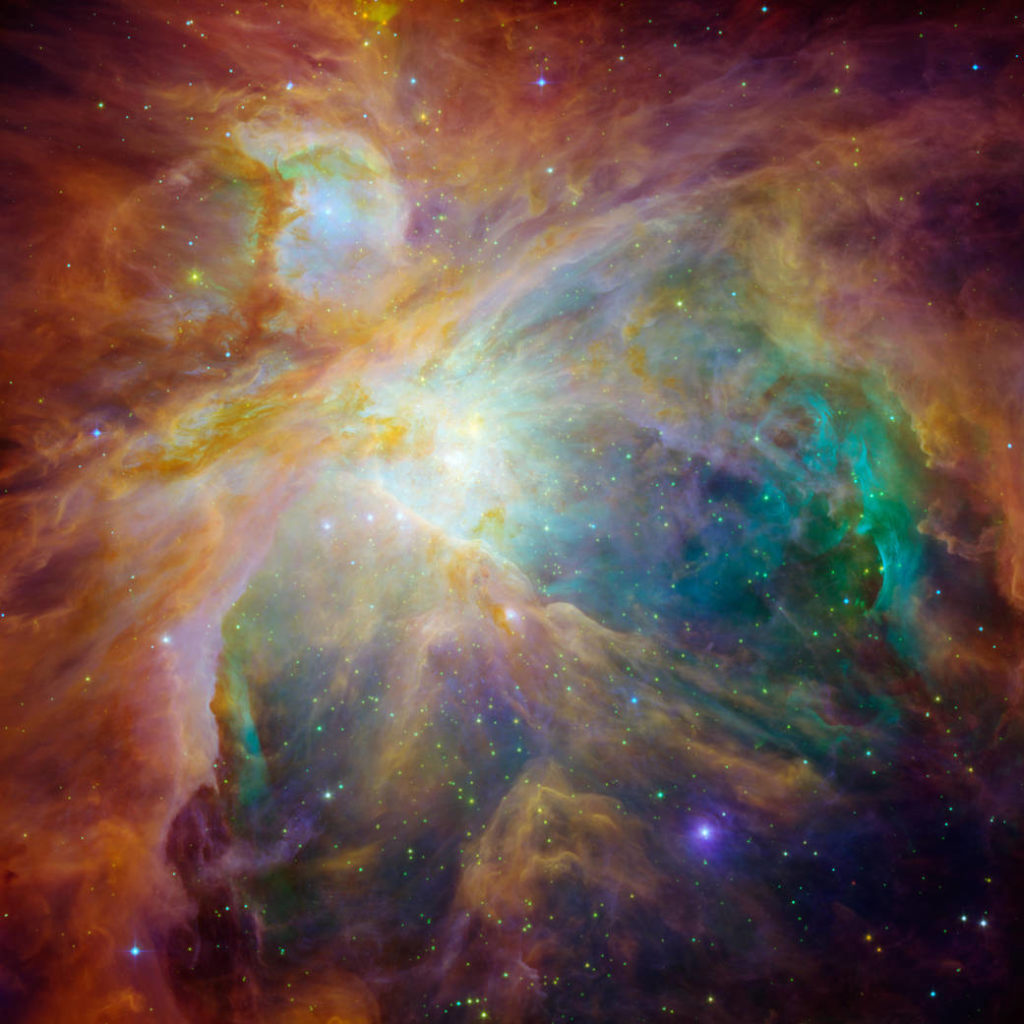
NASA’s Spitzer and Hubble Space Telescopes teamed up to expose the chaos that baby stars are creating 1,500 light years away in a cosmic cloud called the Orion nebula. Courtesy of NASA.
With the advent of spectroscopes and photography, large nebulous areas were revealed as clouds of hydrogen gas and silicate and carbonate dust within the Milky Way. It was John Herschel who made the supposition midway through the eighteenth century that nebulae and star clusters were intimately connected, and paraphrased the nebulae as being the “chaotic material of future suns,” a term that turned out to be very prescient.
It was the great American astronomer Edwin Hubble who finally made the connection between HII regions, dark nebulae, reflection nebulae, and the stars that illuminate them in a seminal paper entitled The Source of Luminosity in Galactic Nebulae, published in the Astrophysical Journal in August, 1922. Here he showed that the ionization from bright stars led to the emission lines of the nebulae, and supposed that dark nebulae and reflection nebulae were areas of sky where the illumination was coming from stars newly born or, in the case of dark nebulae, were as yet unilluminated, as stars were yet to form in them. Later studies in the late 1920s and into the 1930s by Otto Struve, Herman Zanstra, Phillip Keenan, and others showed the nature of reflection nebulae in such objects as the Pleiades and the nebulae in Orion, Messier 78.
Today we can understand the connection between the true nebulae and objects of many kinds such as star clusters, and individual stars, too.
Nebulae
There is nothing quite like the sight of a glowing patch of gas in the eyepiece to start the imagination on a train of thought that leads right down to the production of you and I here on Earth. Nebulae are usually taken to be emission regions of glowing gas illuminated by newly formed stars. However, there are other types, some of which are wonderful objects in their own right, such as Planetary nebulae, the death of stars with masses close to that of the sun. By definition, nebulae are patches of gas or “clouds” but that hides the distinctiveness of each type.
Nebulae can therefore be divided into emission nebulae, planetary nebulae, dark nebulae, and reflection nebulae. Although there are also special subsets, such as supernovae remnants, the main types here are recognized by professional and amateur astronomer alike. No matter what nebulae one may pick, they are all intimately tied to the stellar evolution process.
Stars experience stages of birth, growth, middle age, old age, and finally death. Astronomers talk of these stages as progressive stellar evolution. They begin with dark, emission, and reflection nebulae and generally end with a planetary nebula or the expanding mass of a supernova explosion. Stars are the only entities in our universe that follow the strict rule of evolution, slowly changing with time, but they always remain stars for the majority of their lives.
Before stars begin to form in emission nebulae, their materials are corralled together in large molecular clouds which are warm yet unlit collections of basic gas and dust. These molecular clouds can be enormous, stretching hundreds of light years across and having masses of millions of times that of our sun. Being so large, one would think that it would be easy to see such clouds, but by their very nature, anything that does not emit light in the blackness of space is going to be difficult to spot.
Most of the dark nebulae studied in our galaxy are known as “Barnard Objects” after Edward Emmerson Barnard, the man responsible for identifying them by means of photography at Mount Wilson. Approximately 80 of E. E. Barnard’s dark nebulae are half a degree or larger in size. To see them, they require contrast against the starry backdrop of the Milky Way, and so a large field of view or the naked eye is best for seeing many of them. Examples such as the coal sack in the southern hemisphere or the Cygnus rift in the northern hemisphere are ones that spring to most minds. In many cases a pair of binoculars will suffice for most dark nebulae, though photography brings them out beautifully against the starry canvas of our galactic home.
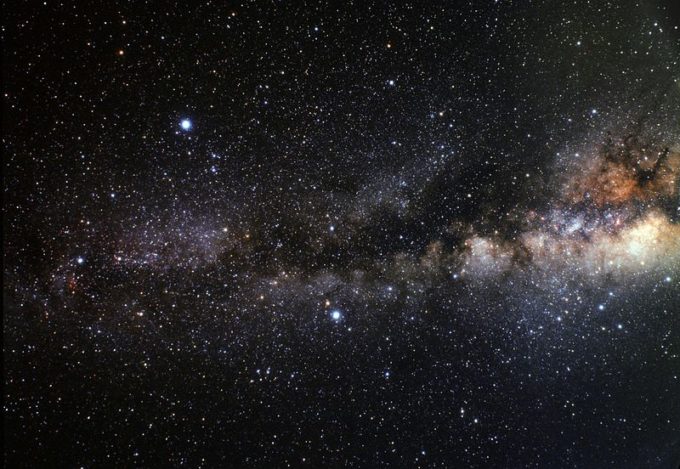
Image of the Great Rift—a dusty lane that stretches from the constellation Cygnus to Sagittarius.
Some of the best examples of dark nebulae are B33, the Horsehead nebula in Orion, Le Gentil’s nebula in northern Cygnus, and the lovely B59, the Pipe nebula in Ophiuchus
As materials collapse and condense inside molecular clouds, local condensations lead to the production of protostars and eventually new stars. These newborns are highly energetic and their radiation energizes part of the molecular clouds until they begin to shine of their own accord. We see such areas as emission nebulae. Astronomers label emission nebulae as HII regions, or ionized hydrogen clouds, which really are the glowing nurseries of stars and planets and are full of the materials necessary for life. Although much of this chemistry is relatively simple, there is enough material in an average HII cloud to make several generations of stars, as can be attested to by examination of many of these wonderful regions. Star clusters are evident in their proximity, and the clouds themselves are lit either by radiant members newly born or are hidden by bars of dust giving hints of emergence into a new world around them.
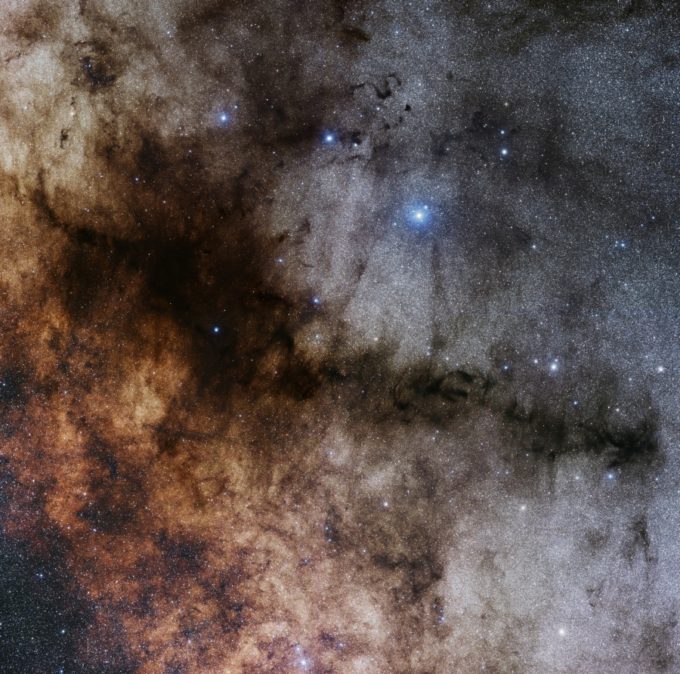
The Pipe Nebula (composed by B77, B78 and B59) is one of the largest dark nebulas in the sky. In this field of view are also visible many other dark nebulae in the network that is the central Milky Way. Image courtesy of Yuri Beletsky (Las Campanas Observatory, Carnegie Institution for Science).
The Pipe Nebula (composed by B77, B78 and B59) is one of the largest dark nebulas in the sky. In this field of view are also visible many other dark nebulae in the network that is the central Milky Way. Image courtesy of Yuri Beletsky (Las Campanas Observatory, Carnegie Institution for Science).
The pipe nebula (composed by B77, B78 and B59) is one of the largest dark nebulas in he sky (7°!). In this field of view are also well visible many other dark nebulas in that intricate network that is the central milky way.
Ionized hydrogen regions are very widespread across the Milky Way, and can even be seen in some external galaxies such as NGC 604 in the Pinwheel galaxy Messier 33. However, not all of them are bright and obvious for the visual observer, and some respond better to photographic efforts than to mere viewing. The subtle red colours of most nebulae are not seen visually as the eye does not discern red easily in the dark, and most objects are fainter than expected.
Excellent examples of HII regions are the winter glory of the Orion nebula M42/43 and the Rosette nebulae NGC 2237 in Monoceros. In summer skies, the wonderful M8 and M20 in Sagittarius or M16 and M17 in Serpens are visited regularly by amateurs.
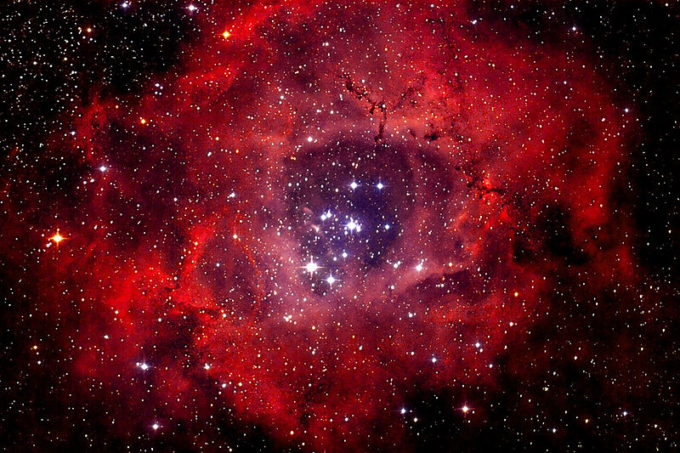
The Rosette Nebula (also known as Caldwell 49) is a large, spherical (circular in appearance), HII region located near one end of a giant molecular cloud in the Monoceros region of the Milky Way Galaxy. Courtesy of Andreas Fink, commons.wikimedia.org.
Once stars are fully formed, converting hydrogen to helium, and generally in equilibrium, we see them as clusters of stars. The bright blue light from such stars or clusters is enough to give sufficient scattering to make the dust visible, and as the light is of short wavelengths, the frequency spectrum of many reflection nebulae is similar to that of the illuminating stars. Reflection nebulae are not particularly rare but their relatively low light profile in comparison to light-emitting nebulae, such as HII regions, make them a little harder to see, and the nebulae are generally well located close to the stars. This makes the starlight overwhelming on occasion and renders visual representation of such nebulae difficult.
Examples such as the Pleiades, or many of the Messier numbers such as M36 – M38 in Auriga, show us how stars born in HII regions stay together for long periods before interaction with the galaxy thins them out into individuals. It is when the stable relationship of hydrogen burning ends that stars begin the next process of nebulae formation—dying in a planetary nebulae or exploding as a supernova.
Stellar Death and Nebulae
This ending depends on the mass of the star. A star larger than 15 times the mass of our sun will become a supernova, whilst those under this limit will become planetary nebulae. Most stars convert hydrogen to helium for millions or even billions of years, but once the hydrogen begins to run out, the star is doomed.
Once there is sufficient helium build-up in the core to significantly interfere with the hydrogen reactions, the core shuts down and begins to contract. However, there is a lot of latent energy in the overlying layers from radiation attempting to escape the outer envelope. As a consequence of this radiation pressure, the star will begin to expand, as gravity works primarily upon the greater mass of the core and only has a relatively weak effect on the outer layers. At this point the core contracts, the outer layers expand, and the star begins to cool.
As it does this, the star changes colour and cools to become an orange K type sub-giant. The star then utilizes the energy of hydrogen-helium conversion, which now takes place in a shell around the inert hydrogen core rather than throughout the core as in its previous incarnation. Over time the star will continue to expand and cool until it becomes an M type red giant. It is now large, luminous, and has an extensive solar wind, which is driving the material of the outermost layers off the star. This expulsion of material is important in the development of a planetary nebula. Under such forces, a star can lose as much as 1/100,000th of a solar mass per year.
Eventually, gravity compresses the helium core until sufficient pressures and temperatures build up inside to fuse helium to carbon. Once a new source of energy has been established, the star has a short stay of execution. However, there is insufficient helium fuel to power the star, and as this fuel becomes exhausted, the outer layers expand again with latent energy from the radiation release and they are eventually pushed off the star, lost to space with an increase in the power of the stellar wind at this stage. Once the luminous outer envelope of the star is lost, the naked core is all that is left: a small, hot remnant with a fraction of the luminosity of the whole star, and the object dims appreciably and makes its way rapidly ending its days as a white dwarf. That is what planetary nebulae are—the thrusting away of the envelope and the exposing of the white dwarf remnant.
Observing planetary nebulae is not particularly difficult, as there are several good examples for amateur study. The Messier objects M27 and M57 in Vulpecula and Lyra are beautiful objects that stand out against the starry backdrop of the Milky Way, whilst M97 in Ursa Major, NGC 7662 in Andromeda, and NGC 6543 in Draco are lovely examples of their type.
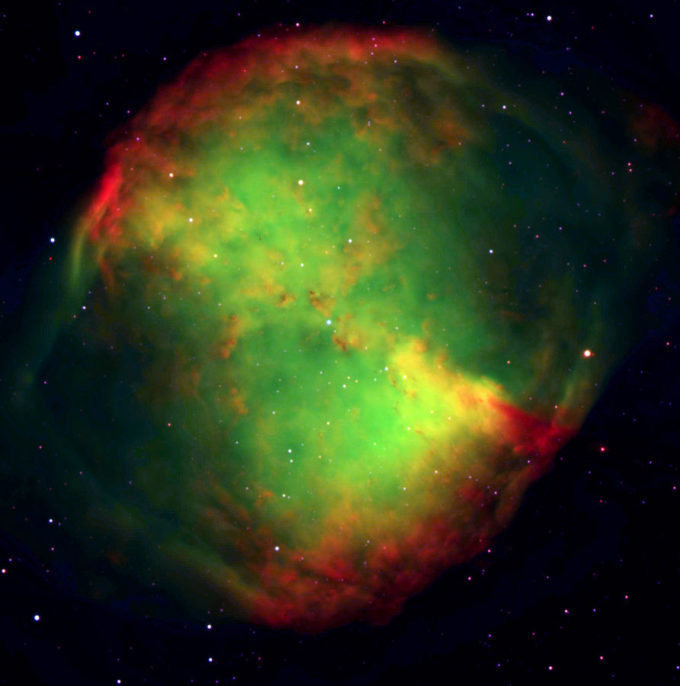
Dumbell Nebula (Messier 27), processed and combined using IRAF and MaxIm DL. Courtesy of Mohamad Abbas, commons.wikimedia.org.
Conversely, the death of a massive star is a relatively rare event. This is partly because such stars are rare in numbers within the galaxy. Nevertheless, there are enough of these rare but exciting objects to become worthy of study, and they generally give themselves away due to the expulsion of materials in shells or nebulous clouds. Stars such as Wolf-Rayet types have large UV excess or are termed Luminous Blue Variables (LBV) and are great candidates for supernova explosions. Massive stars which are ending their lives as red giants, such as Betelguese in Orion, are also appropriate candidates for spectacular explosions. Massive stars continue the fusion process from hydrogen to helium, through carbon, oxygen, nitrogen neon, aluminium, silicon, and others right up to the iron stage. Once the silicon is turned to iron in the core, the last (exothermic) process that holds the star up against gravity is over. To make iron fuse into the next generation of heavier elements it is necessary to inject energy in to the star, as the process is endothermic—it needs energy just to keep going.
No energy is available at this stage, and so the core falters and is squeezed by the overlying layers, and the materials break down allowing a huge implosion of the core. This implosion rebounds, and the outer layers falling in under gravity are met by an enormous shock wave which causes the formation of elements heavier than iron on the periodic table in a process known as explosive nucleosynthesis. The resultant explosion of the star spreads its outer layers into space at a very rapid acceleration—up to 60,000km a second—and the light from the explosion is so bright that it can outshine entire galaxies for a brief period.
The expanding gasses may be lit by radiation for a few months and by the conversion of Ni56 to Fe56 but the light fades eventually to leave an expanding patch of gasses. The core at this stage either becomes a black hole, dependent on how much mass has been shed by the core over the last gasps of its lifetime, or a neutron star like the one in the Crab nebula. The synchrotron radiation from the neutron star, which has now become a pulsar, is then responsible for the ionization of the expanding nebula.
By their brief and ethereal nature, there are very few supernova remnants available for amateur study. The best known examples are the Crab nebula in Taurus and the Veil nebula in Cygnus.
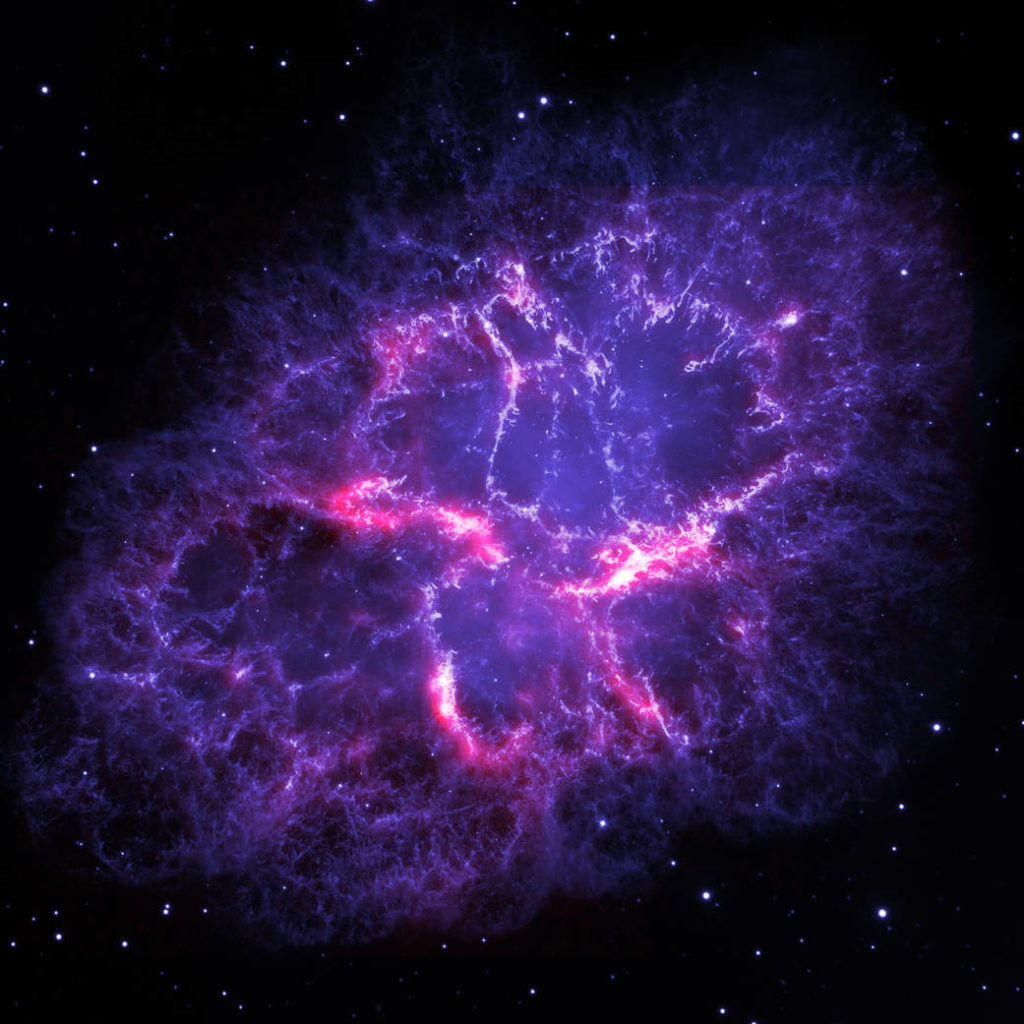
This new Hubble image—one among the largest ever produced with the Earth-orbiting observatory—shows the most detailed view so far of the entire Crab Nebula ever made. The Crab is arguably the single most interesting object, as well as one of the most studied, in all of astronomy. The image is the largest image ever taken with Hubble’s WFPC2 workhorse camera. The Crab Nebula is one of the most intricately structured and highly dynamical objects ever observed. The new Hubble image of the Crab was assembled from 24 individual exposures taken with the NASA/ESA Hubble Space Telescope and is the highest resolution image of the entire Crab Nebula ever made. Courtesy of NASA.
Conclusion
Nebulae come in all shapes and sizes and different brightness. Some will be right at the edge of your observing ability whilst others will be well within reach. The application of photography by many amateur astronomers today render images which would challenge those from a major observatory only 50 years ago. The life cycle from gas cloud to star back to gas cloud is a reminder that the universe is constantly recycling materials, and that the rubbish of yesteryear is actually the future of stars, planets, and possibly even life elsewhere. Getting to know and appreciate their beauty and their stories gives us a fresh perspective on our place in the cosmos and an endless vista of wonderful objects to observe.
Gallery of Author’s Images
- Messier 42, 43
- Messier 20, 21
- Messier 16
- Messier 8, 20, 21
About the Author
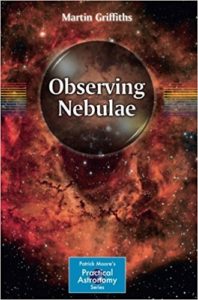 Martin Griffiths is an enthusiastic science communicator, writer and professional astronomer. He is a recipient of the Astrobiology Society of Britain’s Public Outreach Award (2008) and the Astronomical League’s Outreach Master Award (2010). He is currently an astronomer at the University of South Wales in the UK, and a consultant to the Welsh Government through his involvement with the Dark Sky Discovery initiative, enabling public access to dark sky sites in association with Dark Sky Wales, Dark Sky Scotland, and Natural England. He was also responsible for surveying the sky quality of the Brecon Beacons National Park in their successful bid to gain International Dark Sky Association Dark Sky Reserve status in 2013 and is a consultant to the Hay Tourism Board for their annual dark sky festivals. Griffiths is the Director of the Brecon Beacons Observatory, a public and education resource, fitted with a 30cm telescope situated in the Dark Sky Reserve. He is also a Fellow of the Royal Astronomical Society; a Fellow of the Higher Education Academy; a member of the Astrobiology Society of Britain; the European Society for the History of Science: the British Astronomical Association; the British Science Association; and the Webb Deep-Sky Society.
Martin Griffiths is an enthusiastic science communicator, writer and professional astronomer. He is a recipient of the Astrobiology Society of Britain’s Public Outreach Award (2008) and the Astronomical League’s Outreach Master Award (2010). He is currently an astronomer at the University of South Wales in the UK, and a consultant to the Welsh Government through his involvement with the Dark Sky Discovery initiative, enabling public access to dark sky sites in association with Dark Sky Wales, Dark Sky Scotland, and Natural England. He was also responsible for surveying the sky quality of the Brecon Beacons National Park in their successful bid to gain International Dark Sky Association Dark Sky Reserve status in 2013 and is a consultant to the Hay Tourism Board for their annual dark sky festivals. Griffiths is the Director of the Brecon Beacons Observatory, a public and education resource, fitted with a 30cm telescope situated in the Dark Sky Reserve. He is also a Fellow of the Royal Astronomical Society; a Fellow of the Higher Education Academy; a member of the Astrobiology Society of Britain; the European Society for the History of Science: the British Astronomical Association; the British Science Association; and the Webb Deep-Sky Society.


